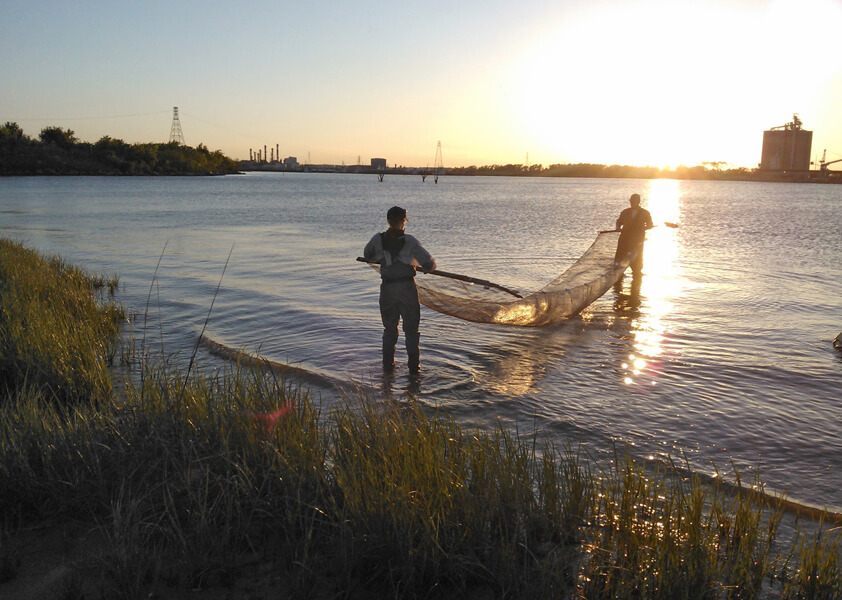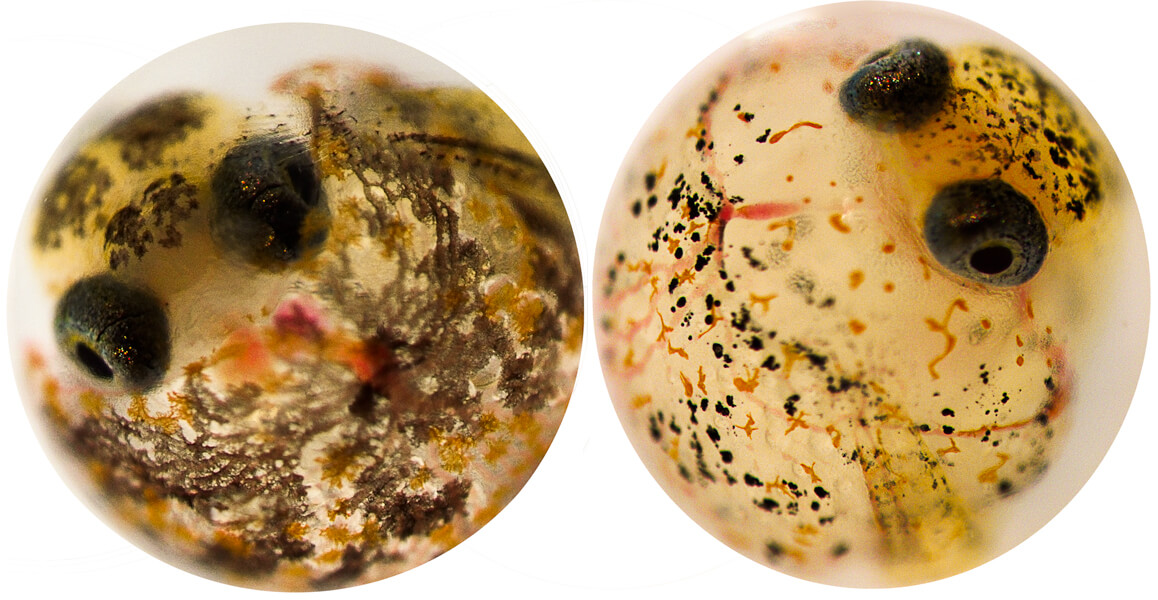With their bright, varied hues and patterns, killifish are attractive aquarium choices. But they’re more than visually appealing — they’re also fascinating creatures to study in the wild, and for not-so-pretty reasons. These fish, along with other marine creatures, are assaulted by industrial and urban contaminants. And as it turns out, killifish can be surprisingly tough.
In 1970s and 1980s, researchers noticed that fish species living adjacent to Superfund sites — toxic waste sites in the US — along the Atlantic Ocean were disappearing. The killifish, though, seemed to defy all odds and survive. And at first blush, these small creatures looked normal. “It wasn’t Blinky the fish with three eyes,” says Andrew Whitehead, an environmental toxicologist at the University of California, Davis.
To Whitehead, who has studied the genetics of killifish for more than a decade, the creatures offer a lens to examine the toxic legacy of industrial pollution. In 2017, he coauthored an article in the Annual Review of Animal Biosciences that documents the impacts of pollution on fish — and how killifish (Fundulus) managed to defy the odds. This interview has been edited for length and clarity.
How did you get interested in using fish as a lens to study pollution?
I was trained as an environmental toxicologist but I’ve always had this interest in ecology and evolutionary theory. Toxicology was very appealing because it’s a science that blends a lot of different sciences, but is also a practical way of studying how humans affect ecosystems, and perhaps to help contribute solutions.
When I was at my first faculty job at Louisiana State University in Baton Rouge, I was very fortunate to get a big National Science Foundation grant for my project. We were studying the health and physiology of fish from sites we thought were polluted with oil after Hurricane Katrina. But that project failed: The freezer I kept all my samples in lost power over a weekend, and it was not a repeatable experiment.
Still, I had all this money from the National Science Foundation, and I’d been really curious to follow up on a story about killifish pollution resistance I’d heard about a decade earlier. I explained to the NSF why the original project failed, but that I had a plan! I wanted to use the grant money to study killifish. That was our first foray into pollution adaptation in killifish. It was a bit serendipitous, but it had been a long-term interest.
What was that story?
Since the late 1990s, my colleagues at the Environmental Protection Agency had been studying fish populations around Superfund sites, which are among the most horribly polluted places in North America. And the scientists found normal, healthy-looking killifish swimming around in these sites. That was surprising. EPA researcher Diane Nacci helped break that story, and her early publications demonstrated that killifish from these polluted sites were incredibly resistant compared with killifish from clean sites, which are normally quite sensitive to the toxic effects of these chemicals.
A few folks in the toxicology world knew about these fish, but really nobody in the evolutionary biology world. And that’s what we brought to the table: the ability to dig into how these killifish became resistant.

Researchers use a seine net to catch killifish in a polluted site in Galveston Bay, Texas.
CREDIT: PHOTO BY ELIAS OZIOLOR
What pollutants are we talking about, and what do we know about how they affect fish?
PAHs and PCBs, or polycyclic aromatic hydrocarbons and polychlorinated biphenyls, are very large classes of chemicals. They’re common pollutants from oil spills or industrial pollution. They’re in the air, soil, water and sediment, especially in urban environments. They’re pretty ubiquitous, so everything’s exposed to PAHs and PCBs — including us and wildlife.
Many of them are exquisitely toxic to developing vertebrates, especially when organs like the heart are developing. People have discovered over the last couple of decades that the way PAHs and PCBs mess with development appears to involve disrupting the cardiovascular system.
Sometimes that’s outright lethal. If fish embryos areexposed to high enough concentrations, the heart gets screwed up enough that they don’t even hatch.
Or the embryos might hatch just fine, but once they grow up and are exercised really hard, you realize that their hearts don't develop properly. So exposure can have really subtle effects that might not emerge until later in development and can happen at very, very low concentrations of these chemicals. This is a pretty similar response whether you’re a fish, a mouse or a human.
So the overall impacts of even just one class of chemicals sound grim.
Yes, and most of these Superfund sites have reduced species diversity. There are a lot of species that you find in nearby clean sites but you don’t find in these really, really polluted sites. It’s just too deadly a place to live.
But then the killifish have what seem like superpowers, right?
It was surprising to notice killifish around the Superfund sites because killifish are known to be pretty sensitive to the toxic effects of a lot of these chemicals. We thought: If there’s anything that’s not going to be there, it would be killifish.
After a few years of research, it seemed clear that the killifish at Superfund sites had evolved resistance. The killifish are a really huge exception to the rule: Most species will respond by mainly suffering and disappearing. It is a pretty remarkable thing to go from a fish that’s normally sensitive to one that’s wickedly resistant in just a few dozen generations. And what’s cool about the killifish is also what’s terrible about it: This has been replicated multiple times, and we don’t have a lot of examples of an evolution experiment in nature that’s been replicated.
How could the killifish have survived, seemingly against all odds?
Part of the reason these killifish have evolved resistance is that they have ridiculously large population sizes — and most other fish species don’t. In many urban estuaries, they’re the most abundant animal species with a backbone. They’re there in the millions. So that kind of population is able to carry lots of different kinds of mutations, whereas less genetic variation is found in smaller populations.
So if you’re going to evolve to survive toxic levels of a pollutant, the genetic mutations that offer resistance must be present somewhere in the population in order for some individuals to survive. If they’re not there, you’re going to go extinct before new mutations appear. When you look at killifish, they’re almost off the scale in terms of genetic diversity compared to other vertebrates. That’s part of the reason they’ve been able to evolve so quickly: They were already carrying the winning cards in their deck.
“It is a pretty remarkable thing to go from a fish that’s normally sensitive to one that’s wickedly resistant in just a few dozen generations.”
Andrew WhiteheadAnd the results of this evolution are astounding. The killifish are thousands of times more resistant, meaning that they can tolerate up to 6,000 times the normally lethal concentration of PAHs. It’s a very extreme change that’s happened in a few dozen generations.
Why is it valuable to study killifish and pollution? What can it teach us?
It’s really hard to isolate how much PAHs or PCBs affect human health; we can’t do those experiments. We can only do associations. But we can do these experiments in fish and study the incidence of congenital heart disease, for example.
In the lab, we can put teeny killifish embryos in glass vials and test a defined concentration of our toxic chemical in that vessel. And the embryos are easy to studybecause they’re transparent: We can look at the heart without having to break open the embryo. As we try to determine risk factors for environmentally induced diseases in humans, I think killifish can really help us understand that.
From that, we can identify the genetic variants that affect sensitivity to chemically induced disease in killifish, and that might help us in our search for those genetic variants in humans.

This photograph shows eggs containing embryos of the Gulf killifish (Fundulus grandis) from a resistant population (left) and a sensitive population (right). Both were exposed to the same concentration of industrial contaminants. The embryo from the resistant population has developed a normal two-chambered heart with proper blood flow, whereas the sensitive embryo has developed an abnormal heart with no blood flow and is not likely to survive to hatch.
CREDIT: PHOTO BY ELIAS OZIOLOR
How do these findings track with the effects of the same chemicals on human health?
We know that a lot of environmentally induced disease in humans, including congenital heart disease, has to do with exposure to certain chemicals. That’s essentially what’s happening in normal killifish that are exposed to these chemicals: Their hearts don’t develop properly. We know that in humans there is a higher incidence of congenital heart disease in areas of higher pollution.
In killifish, we’re finding that changes in genes involved in what’s known as the aryl hydrocarbon receptor signaling pathway are driving resistance to pollutants like PAHs. That makes sense, because this class of pollutants will bind to the receptors in this biochemical pathway and alter gene activity, cause physical abnormalities and decrease survivorship in those fish.
Can they spread these genes into other fish populations naturally?
We recently stumbled across a discovery that one of the two key mutations in the Gulf coast species of killifish from a population in the Houston Ship Channel originated from the Atlantic Coast species. They’re different species of killifish, but they’re reasonably closely related.
That was a jaw-dropper for us. It was totally unexpected because these fish don’t move that far by themselves. They hitched a ride somehow.
So where do we go from here? These killifish are resistant to pollution. We already know they can move resistance genes around into other killifish species. Could one engineer resistance into fish that are more sensitive so that they can survive?
I think that’s a really natural human instinct — to think about using this information to tweak things and improve nature. But the answer to that is, no, it’s not going to happen.
The genetic engineering — we probably can’t do it. Even if we could, it probably won’t work and it would be way more expensive than just cleaning up the pollution.
So why not just stop the pollution? That’s something that we can do and we know will work. I like to say, the roof is leaking. We could get more people with more buckets to catch the water. We could get more efficient buckets that are easier to fill, and people to be at the right place in the right room at the right time. Or, we could just go plug the hole.
Evolution has been the solution to pollution for one species of fish that we know about. Think of all those other species that disappeared from heavily polluted environments because they couldn’t survive. What we’ve learned from the killifish is why it was so hard to evolve that resistance — because you need to be a species with massive genetic resources and huge population sizes to be able to survive this kind of environment.
Here we’ve got one superstar species that’s got the biggest genetic gas tank of almost any vertebrate animal. Most other species we care about don’t have those kinds of capabilities. The story of the killifish is an important, cautionary tale. It’s a demonstration of how hard it is for nature to find its way out of these kinds of stresses.




